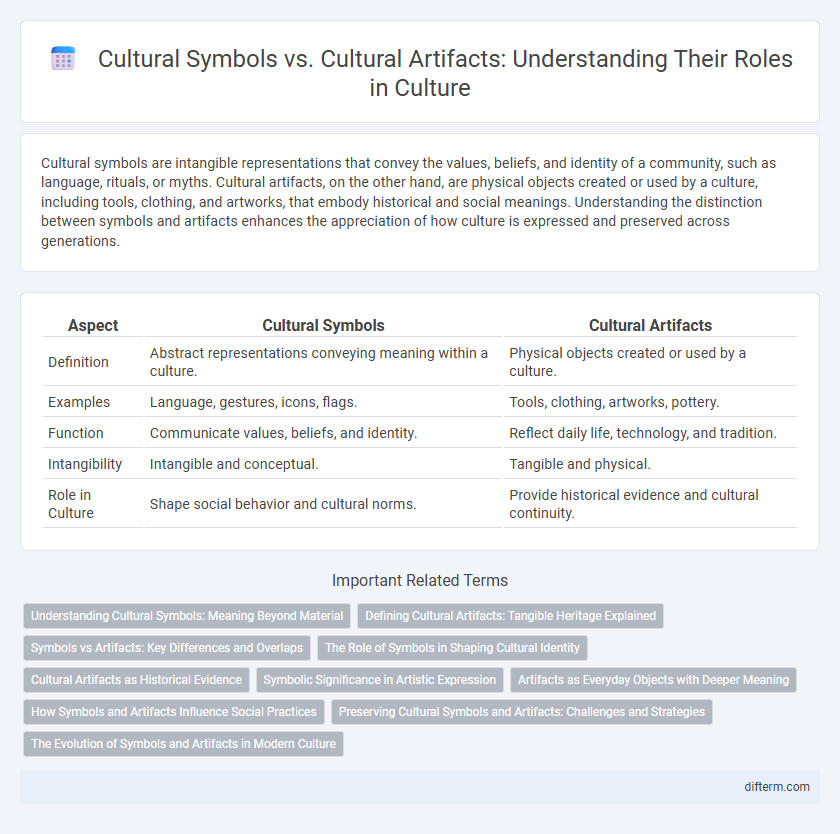Cultural symbols are intangible representations that convey the values, beliefs, and identity of a community, such as language, rituals, or myths. Cultural artifacts, on the other hand, are physical objects created or used by a culture, including tools, clothing, and artworks, that embody historical and social meanings. Understanding the distinction between symbols and artifacts enhances the appreciation of how culture is expressed and preserved across generations.
Table of Comparison
| Aspect | Cultural Symbols | Cultural Artifacts |
|---|---|---|
| Definition | Abstract representations conveying meaning within a culture. | Physical objects created or used by a culture. |
| Examples | Language, gestures, icons, flags. | Tools, clothing, artworks, pottery. |
| Function | Communicate values, beliefs, and identity. | Reflect daily life, technology, and tradition. |
| Intangibility | Intangible and conceptual. | Tangible and physical. |
| Role in Culture | Shape social behavior and cultural norms. | Provide historical evidence and cultural continuity. |
Understanding Cultural Symbols: Meaning Beyond Material
Cultural symbols represent abstract meanings and collective values that transcend their physical forms, serving as powerful tools for communication within a society. Unlike cultural artifacts, which are tangible objects created or used by a culture, symbols carry deeper emotional and ideological significance that shapes identity and social cohesion. Understanding cultural symbols requires interpreting these underlying messages and recognizing their role in reinforcing traditions, beliefs, and collective memory.
Defining Cultural Artifacts: Tangible Heritage Explained
Cultural artifacts are tangible objects created or used by a society that reflect its cultural heritage, such as tools, clothing, artwork, and architecture. Unlike cultural symbols, which are intangible representations of values or ideas, artifacts provide physical evidence of historical practices and traditions. These objects serve as key sources for understanding the daily life, beliefs, and technological advancements of past cultures.
Symbols vs Artifacts: Key Differences and Overlaps
Cultural symbols represent abstract ideas, values, or beliefs that convey meaning within a society, such as flags, languages, or religious icons. Cultural artifacts are tangible objects created, used, or valued by a culture, including tools, clothing, artworks, and architecture. While symbols exist primarily as representations of deeper cultural significance, artifacts embody and preserve cultural history, often serving as physical manifestations of symbolic meanings.
The Role of Symbols in Shaping Cultural Identity
Cultural symbols serve as powerful representations that communicate shared values, beliefs, and traditions within a community, playing a crucial role in shaping collective cultural identity. Unlike cultural artifacts, which are tangible objects reflecting historical and material culture, symbols function as abstract markers that foster social cohesion and continuity across generations. Through rituals, language, and visual emblems, symbols reinforce a community's unique worldview and establish a sense of belonging.
Cultural Artifacts as Historical Evidence
Cultural artifacts serve as tangible historical evidence that reveals the values, beliefs, and technological advancements of past societies, making them crucial in understanding human history. Unlike cultural symbols, which represent abstract meanings often transmitted through language or tradition, artifacts provide direct physical insight into daily life, social structures, and cultural practices. Archaeological findings such as tools, pottery, and clothing enable scholars to reconstruct historical contexts and trace cultural evolution with greater accuracy.
Symbolic Significance in Artistic Expression
Cultural symbols convey abstract meanings and shared values that are essential in artistic expression, serving as metaphors that resonate across communities. Cultural artifacts, including sculptures, paintings, and textiles, embody these symbols physically, providing tangible connections to heritage and tradition. The symbolic significance of these artifacts enhances cultural identity, allowing artists to communicate complex ideas and emotions through visually encoded messages.
Artifacts as Everyday Objects with Deeper Meaning
Cultural artifacts are everyday objects that carry deeper meanings and represent the values, beliefs, and history of a community. Unlike cultural symbols, which are often abstract or emblematic, artifacts provide tangible evidence of cultural practices and traditions through items such as pottery, tools, and clothing. These artifacts offer insights into the social identity and collective memory of a culture by connecting present generations with their ancestral heritage.
How Symbols and Artifacts Influence Social Practices
Cultural symbols, such as language, rituals, and icons, convey shared meanings that shape collective identity and guide social behaviors within a community. Cultural artifacts, including tools, clothing, and architecture, materialize these symbols, reflecting historical experiences and influencing everyday practices. Together, symbols and artifacts reinforce social norms and facilitate cultural continuity by embedding values into tangible and intangible elements of society.
Preserving Cultural Symbols and Artifacts: Challenges and Strategies
Preserving cultural symbols and artifacts involves safeguarding tangible objects like traditional clothing, tools, and artworks, alongside intangible elements such as language, rituals, and beliefs that embody a community's identity. Challenges include environmental degradation, urbanization, and loss of traditional knowledge, which threaten both physical artifacts and symbolic meanings. Effective strategies encompass digital documentation, community-led conservation programs, and legal protections to ensure the continuity of cultural heritage across generations.
The Evolution of Symbols and Artifacts in Modern Culture
Cultural symbols represent abstract ideas and shared meanings that evolve with societal values, while cultural artifacts are tangible objects embodying historical and cultural significance. In modern culture, the transformation of symbols reflects changing ideologies and digital communication trends, whereas artifacts increasingly integrate technology, preserving heritage in innovative forms. This dynamic interplay highlights how culture adapts through both symbolic representation and material heritage to shape contemporary identity.
Cultural symbols vs Cultural artifacts Infographic

 difterm.com
difterm.com